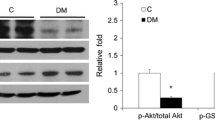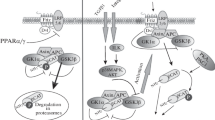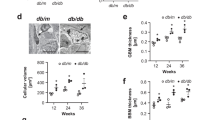Abstract
Podocyte hypertrophy and apoptosis are two hallmarks of diabetic glomeruli, but the sequence in which these processes occur remains a matter of debate. Here we investigated the effects of inhibiting hypertrophy on apoptosis, and vice versa, in both podocytes and glomeruli, under diabetic conditions. Hypertrophy and apoptosis were inhibited using an epidermal growth factor receptor inhibitor (PKI 166) and a pan-caspase inhibitor (zAsp-DCB), respectively. We observed significant increases in the protein expression of p27, p21, phospho-eukaryotic elongation factor 4E-binding protein 1, and phospho-p70 S6 ribosomal protein kinase, in both cultured podocytes exposed to high-glucose (HG) medium, and streptozotocin-induced diabetes mellitus (DM) rat glomeruli. These increases were significantly inhibited by PKI 166, but not by zAsp-DCB. In addition, the amount of protein per cell, the relative cell size, and the glomerular volume were all significantly increased under diabetic conditions, and these changes were also blocked by treatment with PKI 166, but not zAsp-DCB. Increased protein expression of cleaved caspase-3 and cleaved poly (ADP-ribose) polymerase, together with increased Bax/Bcl-2 ratios, were also observed in HG-stimulated podocytes and DM glomeruli. Treatment with either zAsp-DCB or PKI 166 resulted in a significant attenuation of these effects. Both PKI 166 and zAsp-DCB also inhibited the increase in number of apoptotic cells, as assessed by Hoechst 33342 staining and TUNEL assay. Under diabetic conditions, inhibition of podocyte hypertrophy results in attenuated apoptosis, whereas blocking apoptosis has no effect on podocyte hypertrophy, suggesting that podocyte hypertrophy precedes apoptosis.










Similar content being viewed by others
References
Collins AJ, Foley RN, Chavers B, Gilbertson D, Herzog C, Johansen K, Kasiske B, Kutner N, Liu J, St Peter W, Guo H, Gustafson S, Heubner B, Lamb K, Li S, Peng Y, Qiu Y, Roberts T, Skeans M, Snyder J, Solid C, Thompson B, Wang C, Weinhandl E, Zaun D, Arko C, Chen S, Daniels F, Ebben J, Frazier E, Hanzlik C, Johnson R, Sheets D, Wang X, Forrest B, Constantini E, Everson S, Eggers P, Agodoa L (2012) United states renal data system 2011 annual data report: atlas of chronic kidney disease & end-stage renal disease in the United States. Am J Kidney Dis 59(1 Suppl 1):A7, 1–420
Schrijvers BF, De Vriese AS, Flyvbjerg A (2004) From hyperglycemia to diabetic kidney disease: the role of metabolic, hemodynamic, intracellular factors and growth factors/cytokines. Endocr Rev 25(6):971–1010
Leehey DJ, Singh AK, Alavi N, Singh R (2000) Role of angiotensin II in diabetic nephropathy. Kidney Int Suppl 77:S93–98
Hoffman BB, Sharma K, Ziyadeh FN (1998) Potential role of TGF-beta in diabetic nephropathy. Miner Electrolyte Metab 24(2–3):190–196
Baumgartl HJ, Sigl G, Banholzer P, Haslbeck M, Standl E (1998) On the prognosis of IDDM patients with large kidneys. Nephrol Dial Transplant 13(3):630–634
Furuta T, Saito T, Ootaka T, Soma J, Obara K, Abe K, Yoshinaga K (1993) The role of macrophages in diabetic glomerulosclerosis. Am J Kidney Dis 21(5):480–485
Ayo SH, Radnik RA, Glass WF, Garoni JA, Rampt ER, Appling DR, Kreisberg JI (1991) Increased extracellular matrix synthesis and mRNA in mesangial cells grown in high-glucose medium. Am J Physiol 260:F185–191
Hostetter TH (2003) Hyperfiltration and glomerulosclerosis. Semin Nephrol 23(2):194–199
Wolf G (2004) New insights into the pathophysiology of diabetic nephropathy: from haemodynamics to molecular pathology. Eur J Clin Invest 34(12):785–796
Osterby R (1992) Glomerular structural changes in type 1 (insulin-dependent) diabetes mellitus: causes, consequences, and prevention. Diabetologia 35(9):803–812
Young BA, Johnson RJ, Alpers CE, Eng E, Gordon K, Floege J, Couser WG, Seidel K (1995) Cellular events in the evolution of experimental diabetic nephropathy. Kidney Int 47(3):935–944
Wolf G, Sharma K, Chen Y, Ericksen M, Ziyadeh FN (1992) High glucose-induced proliferation in mesangial cells is reversed by autocrine TGF-beta. Kidney Int 42(3):647–656
Wolf G (2000) Cell cycle regulation in diabetic nephropathy. Kidney Int Suppl 77:S59–66
Pavenstdt H, Kriz W, Kretzler M (2003) Cell biology of the glomerular podocyte. Physiol Rev 83(1):253–307
Barisoni L, Kriz W, Mundel P, D’Agati V (1999) The dysregulated podocyte phenotype: a novel concept in the pathogenesis of collapsing idiopathic focal segmental glomerulosclerosis and HIV-associated nephropathy. J Am Soc Nephrol 10(1):51–61
Nagata M, Hattori M, Hamano Y, Ito K, Saitoh K, Watanabe T (1998) Origin and phenotypic features of hyperplastic epithelial cells in collapsing glomerulopathy. Am J Kidney Dis 32(6):962–969
D’Agati V (1994) The many masks of focal segmental glomerulosclerosis. Kidney Int 46(4):1223–1241
Petermann AT, Pippin J, Durvasula R, Pichler R, Hiromura K, Monkawa T, Couser WG, Shankland SJ (2005) Mechanical stretch induces podocyte hypertrophy in vitro. Kidney Int 67(1):157–166
Xu Z, Yoo T, Ryu D, Park HC, Ha SK, Han DS, Adler SG, Natarajan R, Kang S (2005) Angiotensin II receptor blocker inhibits p27Kip1 expression in glucose-stimulated podocytes and in diabetic glomeruli. Kidney Int 67(3):944–952
Saikumar P, Dong Z, Mikhailov V, Denton M, Weinberg JM, Venkatachalam MA (1999) Apoptosis: definition, mechanisms, and relevance to disease. Am J Med 107(5):489–506
Shimizu A, Masuda Y, Kitamura H, Ishizaki M, Sugisaki Y, Yamanaka N (1996) Apoptosis in progressive crescentic glomerulonephritis. Lab Invest 74(5):941–951
Kitamura H, Shimizu A, Masuda Y, Ishizaki M, Sugisaki Y, Yamanaka N (1998) Apoptosis in glomerular endothelial cells during the development of glomerulosclerosis in the remnant-kidney model. Exp Nephrol 6(4):328–336
Susztak K, Raff AC, Schiffer M, Bttinger EP (2006) Glucose-induced reactive oxygen species cause apoptosis of podocytes and podocyte depletion at the onset of diabetic nephropathy. Diabetes 55(1):225–233
Verzola D, Gandolfo MT, Ferrario F, Rastaldi MP, Villaggio B, Gianiorio F, Giannoni M, Rimoldi L, Lauria F, Miji M, Deferrari G, Garibotto G (2007) Apoptosis in the kidneys of patients with type II diabetic nephropathy. Kidney Int 72(10):1262–1272
Dalla Vestra M, Saller A, Mauer M, Fioretto P (2001) Role of mesangial expansion in the pathogenesis of diabetic nephropathy. J Nephrol 14(Suppl 4):S51–57
Mundel P, Shankland SJ (2002) Podocyte biology and response to injury. J Am Soc Nephrol 13(12):3005–3015
Marshall SM (2007) The podocyte: a potential therapeutic target in diabetic nephropathy? Curr Pharm Des 13(26):2713–2720
Dalla Vestra M, Masiero A, Roiter AM, Saller A, Crepaldi G, Fioretto P (2003) Is podocyte injury relevant in diabetic nephropathy? Studies in patients with type 2 diabetes. Diabetes 52(4):1031–1035
Jung D, Lee SH, Kwak S, Li JJ, Kim DH, Nam B, Kang HY, Chang TI, Park JT, Han SH, Yoo T, Kang S (2012) Apoptosis occurs differentially according to glomerular size in diabetic kidney disease. Nephrol Dial Transplant 27(1):259–266
Menini S, Iacobini C, Oddi G, Ricci C, Simonelli P, Fallucca S, Grattarola M, Pugliese F, Pesce C, Pugliese G (2007) Increased glomerular cell (podocyte) apoptosis in rats with streptozotocin-induced diabetes mellitus: role in the development of diabetic glomerular disease. Diabetologia 50(12):2591–2599
Herbach N, Schairer I, Blutke A, Kautz S, Siebert A, Göke B, Wolf E, Wanke R (2009) Diabetic kidney lesions of GIPRdn transgenic mice: podocyte hypertrophy and thickening of the GBM precede glomerular hypertrophy and glomerulosclerosis. Am J Physiol Renal Physiol 296(4):F819–829
Kim DK, Nam BY, Li JJ, Park JT, Lee SH, Kim JY, Kang HY, Han SH, Yoo TH, Han DS, Kang SW (2012) Translationally controlled tumour protein is associated with podocyte hypertrophy in a mouse model of type 1 diabetes. Diabetologia 55(4):1205–1217
Mundel P, Reiser J, Zúñiga Mejía Borja A, Pavenstädt H, Davidson GR, Kriz W, Zeller R (1997) Rearrangements of the cytoskeleton and cell contacts induce process formation during differentiation of conditionally immortalized mouse podocyte cell lines. Exp Cell Res 236(1):248–258
Wassef L, Kelly DJ, Gilbert RE (2004) Epidermal growth factor receptor inhibition attenuates early kidney enlargement in experimental diabetes. Kidney Int 66(5):1805–1814
Chandrashekhar Y, Sen S, Anway R, Shuros A, Anand I (2004) Long-term caspase inhibition ameliorates apoptosis, reduces myocardial troponin-I cleavage, protects left ventricular function, and attenuates remodeling in rats with myocardial infarction. J Am Coll Cardiol 43(2):295–301
Li B, Yao J, Kawamura K, Oyanagi Tanaka Y, Hoshiyama M, Morioka T, Gejyo F, Uchiyama M, Oite T (2004) Real-time observation of glomerular hemodynamic changes in diabetic rats: effects of insulin and ARB. Kidney Int 66(5):1939–1948
Kang SW, Adler SG, Nast CC, LaPage J, Gu JL, Nadler JL, Natarajan R (2001) 12-lipoxygenase is increased in glucose-stimulated mesangial cells and in experimental diabetic nephropathy. Kidney Int 59(4):1354–1362
Schwieger J, Fine LG (1990) Renal hypertrophy, growth factors, and nephropathy in diabetes mellitus. Semin Nephrol 10(3):242–253
Okada M, Takemura T, Yanagida H, Yoshioka K (2002) Response of mesangial cells to low-density lipoprotein and angiotensin II in diabetic (OLETF) rats. Kidney Int 61(1):113–124
Shankland SJ (2006) The podocyte’s response to injury: role in proteinuria and glomerulosclerosis. Kidney Int 69(12):2131–2147
Li JJ, Kwak SJ, Jung DS, Kim JJ, Yoo TH, Ryu DR, Han SH, Choi HY, Lee JE, Moon SJ, Kim DK, Han DS, Kang SW (2007) Podocyte biology in diabetic nephropathy. Kidney Int Suppl 72(106):S36–42
Seyer-Hansen K (1976) Renal hypertrophy in streptozotocin-diabetic rats. Clin Sci Mol Med Suppl 51(6):551–555
Rasch R, Nörgaard JO (1983) Renal enlargement: comparative autoradiographic studies of 3H-thymidine uptake in diabetic and uninephrectomized rats. Diabetologia 25(3):280–287
Polyak K, Kato JY, Solomon MJ, Sherr CJ, Massague J, Roberts JM, Koff A (1994) p27Kip1, a cyclin-Cdk inhibitor, links transforming growth factor-beta and contact inhibition to cell cycle arrest. Genes Dev 8(1):9–22
Ruster C, Bondeva T, Franke S, Forster M, Wolf G (2008) Advanced glycation end-products induce cell cycle arrest and hypertrophy in podocytes. Nephrol Dial Transplant 23(7):2179–2191
Mori H, Inoki K, Masutani K, Wakabayashi Y, Komai K, Nakagawa R, Guan K, Yoshimura A (2009) The mTOR pathway is highly activated in diabetic nephropathy and rapamycin has a strong therapeutic potential. Biochem Biophys Res Commun 384(4):471–475
Sataranatarajan K, Mariappan M, Lee MJ, Feliers D, Choudhury GG, Barnes JL, Kasinath BS (2007) Regulation of elongation phase of mRNA translation in diabetic nephropathy: amelioration by rapamycin. Am J Pathol 171(6):1733–1742
Sharma K, Ziyadeh FN (1997) Biochemical events and cytokine interactions linking glucose metabolism to the development of diabetic nephropathy. Semin Nephrol 17(2):80–92
Flannery PJ, Spurney RF (2006) Transactivation of the epidermal growth factor receptor by angiotensin II in glomerular podocytes. Nephron Exp Nephrol 103(3):e109–118
Gilbert RE, Cox A, McNally PG, Wu LL, Dziadek M, Cooper ME, Jerums G (1997) Increased epidermal growth factor in experimental diabetes related kidney growth in rats. Diabetologia 40(7):778–785
Advani A, Wiggins KJ, Cox AJ, Zhang Y, Gilbert RE, Kelly DJ (2011) Inhibition of the epidermal growth factor receptor preserves podocytes and attenuates albuminuria in experimental diabetic nephropathy. Nephrology 16(6):573–581
Reidy K, Kang HM, Hostetter T, Susztak K (2014) Molecular mechanisms of diabetic kidney disease. J Clin Invest 124(6):2333–2340
Das S, Dey KK, Bharti R, MaitiChoudhury S, Maiti S, Mandal M (2012) PKI 166 induced redox signalling and apoptosis through activation of p53, MAP kinase and caspase pathway in epidermoid carcinoma. J Exp Ther Oncol 10(2):139–153
Fujimoto E, Yano T, Sato H, Hagiwara K, Yamasaki H, Shirai S, Fukumoto K, Hagiwara H, Negishi E, Ueno K (2005) Cytotoxic effect of the Her-2/Her-1 inhibitor PKI-166 on renal cancer cells expressing the connexin 32 gene. J Pharmacol Sci 97(2):294–298
Bruns CJ, Solorzano CC, Harbison MT, Ozawa S, Tsan R, Fan D, Abbruzzese J, Traxler P, Buchdunger E, Radinsky R, Fidler IJ (2000) Blockade of the epidermal growth factor receptor signaling by a novel tyrosine kinase inhibitor leads to apoptosis of endothelial cells and therapy of human pancreatic carcinoma. Cancer Res 60(11):2926–2935
Franch HA, Shay JW, Alpern RJ, Preisig PA (1995) Involvement of pRB family in TGF beta-dependent epithelial cell hypertrophy. J Cell Biol 129(1):245–254
White KE, Bilous RW, Marshall SM, El Nahas M, Remuzzi G, Piras G, De Cosmo S, Viberti G (2002) Podocyte number in normotensive type 1 diabetic patients with albuminuria. Diabetes 51(10):3083–3089
Gross ML, Ritz E, Schoof A, Adamczak M, Koch A, Tulp O, Parkman A, El Shakmak A, Szabo A, Amann K (2004) Comparison of renal morphology in the Streptozotocin and the SHR/N-cp models of diabetes. Lab Invest 84(4):452–464
Tunçdemir M, Oztürk M (2011) The effects of angiotensin-II receptor blockers on podocyte damage and glomerular apoptosis in a rat model of experimental streptozotocin-induced diabetic nephropathy. Acta Histochem 113(8):826–832
Toyonaga J, Tsuruya K, Ikeda H, Noguchi H, Yotsueda H, Fujisaki K, Hirakawa M, Taniguchi M, Masutani K, Iida M (2011) Spironolactone inhibits hyperglycemia-induced podocyte injury by attenuating ROS production. Nephrol Dial Transplant 26(8):2475–2484
Peixoto EB, Papadimitriou A, Lopes de Faria JM (2012) Tempol reduces podocyte apoptosis via PARP signaling pathway in experimental diabetes mellitus. Nephron Exp Nephrol 120(2):e81–90
Acknowledgments
This work was supported by the Brain Korea 21 PLUS Project for Medical Science, Yonsei University College of Medicine, the National Research Foundation of Korea (NRF) Grant funded by the Korea government (MSIP) (No. NRF-2011-0030086), and a Grant of the Korean Health Technology R&D Project, Ministry of Health and Welfare, Republic of Korea (HI12C0646).
Confilicts of interest
All the authors declared no competing interests.
Author information
Authors and Affiliations
Corresponding author
Additional information
Sun Ha Lee and Sung Jin Moon contributed equally to this work.
Rights and permissions
About this article
Cite this article
Lee, S.H., Moon, S.J., Paeng, J. et al. Podocyte hypertrophy precedes apoptosis under experimental diabetic conditions. Apoptosis 20, 1056–1071 (2015). https://doi.org/10.1007/s10495-015-1134-0
Published:
Issue Date:
DOI: https://doi.org/10.1007/s10495-015-1134-0




